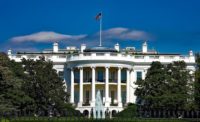Earlier this month, Architectural Record broke the story that the White House was considering an executive order (EO) that would dictate that “the classical architectural style shall be the preferred and default style” for new or upgraded federal buildings.
RECORD had obtained a preliminary draft of the EO, entitled “Making Federal Buildings Beautiful Again,” which decries the quality of architecture under the General Service Administration’s (GSA) Design Excellence Program, for its failure to re-integrate “our national values into Federal buildings.” The document calls for re-writing the Guiding Principles for Federal Architecture, issued in 1962, which became the foundation of the Design Excellence Program. The original principles state that “an official style must be avoided,” and that new federal buildings should reflect their time.
The response to RECORD’s article was instantaneous. Newspapers from San Francisco to London jumped on the story, social media and websites were flooded with comments, and design critics and editorial boards weighed in—most attacking the proposed EO. The AIA issued a statement, opposing “uniform style mandates and the idea of any official architectural style”—and called on its members to to protest; in the first week, nearly 11,000 architects wrote to the president.
The AIA first learned of the EO late last fall. In early January, the executive vice president/CEO Robert Ivy visited the White House to meet with domestic policy aide James Sherk, who denied such an order even existed. But the GSA later acknowledged that aspects of it were already moving forward.
The AIA leadership has also reached out to the chairs of the House and Senate appropriations committees, “strenuously” urging them “to ensure that no funding is appropriated to implement or carry out this new dictate,” arguing, among other objections, that the order could increase the cost of a federal building by as much as two or three times.
Before the draft EO was leaked to the AIA, the organization had been closely following President Trump’s appointments to the U.S. Commission of Fine Arts (FAC), which approves much of the architecture in the capital. The commission has seven expert members, and Trump’s first appointment, in November 2018, was Justin Shubow—who is not an architect but the president of the National Civic Art Society, a non-profit devoted to furthering classical architecture. (Shubow vociferously protested the Eisenhower Memorial, designed by Frank Gehry, which finally will open in May.) The Society’s website contends that “contemporary architecture is by and large a failure,” and seeks “to help architecture return to its pre-Modernist roots.”
This past December, Trump made two more appointments to the FAC: James C. McCrery II, AIA, a founder and board member of the National Civic Art Society, and architect Duncan G. Stroik, AIA, whose work is “informed by the timelessness of classical architecture,” according to the FAC’s website. (The terms of the four other members, appointed by President Obama, expire next December.)
The fingerprints of the National Civic Art Society are all over the proposed EO. In the draft, the mechanism for the imposition of the classical style (traditional regional architecture—such as Spanish colonial—would also be permitted in places like Florida; think Mar-a-Lago) would be a President’s Committee for the Re-Beautification of Federal Architecture. Its members would include the Commissioner of the GSA’s Public Building Service—and at least one member of the FAC. That process would bypass the GSA’s Design Excellence program; the chief architect who supervises it, David Insinga, resigned his post at the end of January.
Many professional organizations have spoken out against the proposed policy including the National Organization of Minority Architects and the American Society of Landscape Architects.
Other opposing voices have come from surprising corners. Michael Lykoudis, dean of the School of Architecture at Notre Dame, which emphasizes classical architecture and traditional urbanism, wrote to the Washington Post of his dismay in learning of the potential order. “Classical architecture is not a style,” he said. “It is a dedication to principles of community, resilience, and beauty.” The proposal “reduces an entire architectural philosophy to caricature.”
Similarly, the Institute of Classical Architecture and Art, a group “dedicated to advancing the appreciation and practice of traditional architecture,” stated it opposed “any government-mandated ‘style’ … and any dictate that narrows public discourse in the design of civic architecture.”
Even the National Trust for Historic Preservation has came out against “any effort to impose a narrow set of styles … based on the architectural tastes of a few individuals.”






Post a comment to this article
Report Abusive Comment